Is there such a thing as a "girls' throw"?
Does exercise lead to a more muscular heart? Why can an unfit cyclist cycle faster than an olympic runner runs? How do kinetic watches work? We answer your questions in this week's Naked Scientists Podcast, and find out why so many dead bugs end up on their backs, how salmonella gets into an egg, and if it's more efficient to fill your freezer than run it half empty? In the news we hear how farming migrated across Europe, why distant stars might have influenced life on Earth, and why rogue DNA can cause heart failure. Plus, we home in on the parts of the pigeon brain that respond to magnetic fields...
In this episode
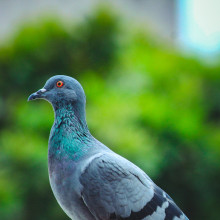
- How pigeons pick up Earth's magnetic field
How pigeons pick up Earth's magnetic field
Scientists have detected the parts of a pigeon's brain that enable it to use the Earth's magnetic field to navigate.
That birds such as pigeons, as well as a host of other animals, are sensitive to magnetic fields and might use them like a cognitive compass to find their way around has been known for some time; but how they detect and then process this information neurologically has remained a grey area.
Now, working with homing pigeons, two researchers from Baylor School of Medicine in Texas, Le-Qing Wu and David Dickson, have identified the parts of the bird brain responsible.
Writing in Science, the duo first exposed pigeons to a changing magnetic field and then looked in the animal's brains for nerve cells that had increased their expression of a gene called c-Fos which is linked to neural activation.
Four areas lit up: the lateral hyperpallium, hippocampus, dorsal thalamus, and caudal vestibular nuclei. These regions are are all known to be involved in navigation functions and in spatial orientation.
Next the researchers used electrodes to record nerve activity in one of these regions, the vestibular nuclei, in seven pigeons.
The animals were tested in the dark to avoid giving them light-related cues. A set of coils were used to generate a magnetic field that cancelled out the planet's natural field and then applied its own.
The researchers varied the orientation of this field, which was equivalent in strength to the Earth's own magnetic field, in 10 degree steps. They were able to show that the cells displayed a "tuning curve" of activity, responding most in some orientations and least in others.
How the birds actually detect the magnetic field in the first place isn't known for sure, but the researchers have so far homed in on a structure called the lagena in the inner ear, which they plan to look at next, although the beak and retina could also be involved.
How do kinetic watches work?
Dave - If you have ever taken a cup of coffee or something with some foam on the top and spun the cup, the coffee stays still, but the cup turns around. This is based on the same principles. There are some weights inside the watch which are free to move and as you move your wrist around, the weights tend to stay still when your wrist is moving, and so they move around and spin around as you move around, and go through your daily life. This relative movement between the weight and the watch is connected to a little generator via some gears and cogs, and that charges the battery. And so, as long as you keep using it and moving around, it will charge the battery up and it should keep going.
Why are so many dead bugs lying on their back?
Diana - This is a bit of a mysterious one, because there's no actual research that has gone into looking at this statistically to prove if it's true. What I think is happening is that when a bug dies, it gets a sort of rigor mortis, and either all of its legs on one side will fold up or it will suddenly get a spring in one side of its legs, and it will sort of flip it over onto its back. And it also could be a question of whether or not it's more stable lying on its back because that's the heaviest part, and it might be the more natural side for it to lie once its legs are all folded up and no longer supporting its body weight. And I have a very sad story to tell actually. I used to have a pet budgie and one day, I came home from school and I found him lying on his back at the bottom of his cage. But obviously, when he was dead, that was the way he was going to lie down because his legs could no longer support him and it would be unstable if he would be on his front so he ends up on his back.
Dave - It could also be that quite a lot of bugs spend their time crawling up walls and things. And so, when they die, they might fall off the wall and so, it could be that falling upside down is the stable way for it to fall through the air because the legs are going to act as tails, so it should fall through the air upside down and end up upside down on the ground.
Why can I cycle faster than the fastest runner?
Dave - There are various different things which could be limiting how fast you can move. There are various mechanical reasons, like you might not actually be able to move your muscles quickly enough or if you're pulling a very heavy weight, it's limited by the amount of force you can apply on the weight. I think in this case it's limited by the amount of power you can put out. Elite athletes are going to be able to put a lot more power out than you are, but you're using a method of transport which is much more efficient. Bikes have been optimised over the course of 150 years to be incredibly efficient. You use very, very little energy to keep going along. In fact you need hardly any energy to keep them going along, it's just to accelerate them and to overcome air resistance, as there's no friction there. So, with a very relatively small amount of power, you can be going very, very fast.
Whereas when running, you've got to move these great big legs around all the time and you actually kind of reach a limit to how fast you can move the legs backwards and forwards. You've got to accelerate and decelerate every time you take a step.
Chris - You're basically accelerating a bag of water weighing at least 60, if not 100 kilos which you're elevating and dropping and decelerating with every step, aren't you? So, you're basically having to keep lifting this very heavy bag up and down, and it's not an efficient way to move.
Dave - And also, you've got your legs, at 10 or 15 kilos each, which you're accelerating backwards and forwards. So all of that takes a huge amount of effort whereas on a bike, all you've got to do is just push this off along through a very efficient mechanical train.
Diana - Perhaps one of the reasons why humans are so good at doing long distances for a long time is because they've only got two legs whereas four-legged animals like horses, although they can go faster, they can't go as fast for as long as humans can because they've got four things to lift up.
Is microwaving food safe?
Dave - There are two aspects to this. One of them - is food in a microwave dangerous to eat? The other is, if you go near a microwave, is it dangerous?
First of all, microwaves are a form of light, a form of electromagnetic radiation. In the spectrum, you go from visible green, yellow, red, into the infrareds, the deep infrareds, through some millimetre waves and then there are microwaves and just beyond that, radio waves. And the further down in that direction you go, the less energy each photon of the light has got. So, the light which is actually dangerous itself is up in the ultraviolet which can give you cancer.
So, microwaves are probably not dangerous - they're certainly not dangerous with regards damaging cells chemically and giving you cancer. You can obviously get too hot from them and overheat because, the piece of chicken in a microwave obviously is getting damaged because that's way it gets more tasty. So, if you had a microwave with a hole in the back and you stood near it, then it would certainly be dangerous. But as long as the microwave is properly designed and you're not standing right up next to it and kind of leaning over it and hugging it, there shouldn't be a problem.
Chris - And it won't do anything to the chemical composition of the food that you're heating up?
Dave - It's heating the food up in broadly the same way as any other means of cooking, just making it hotter. The one difference is that it might not heat it quite as evenly. So you might get parts of the food which have essentially been overheated and if you overheat food then you can reduce the amount of vitamins in it slightly. So it's not going to make it dangerous, but it might make it slightly less good for you.
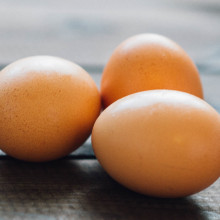
How does salmonella get into an egg?
Chris Smith gave an "eggs-pert" opinion on this question...
Chris - I looked up the number of eggs that are thought to be contaminated with Salmonella in the UK where incidentally, we consume 24 million eggs every day. It's a very huge number. It's nearly 9 billion eggs per year just in the UK, and the estimate is that about 0.3% of them are carrying Salmonella.
The number of organisms that are in the egg in an infected egg is very low - 5 or 6 bacterial particles - and proper storage of the eggs and making sure they're not kept too warm where the bacteria will multiply means that that number stays very low. And if the number stays low, then the chances of acquiring the infection is extremely low. You need a very high dose of Salmonella to make sure that someone will get infected.
The number of cases of Salmonella we get every year are far and away too small to really show that this is having a major impact. We think there's probably under 10,000 cases of Salmonella infection in the UK every year.
How does the bug get into the egg in the first place though? Well, there's a number of routes. One of them is that when chickens catch Salmonella, unlike us, where we get symptoms, it doesn't cause a symptom for a chicken. It can pass from the chicken's ovaries, where it can set up an infection, straight into the egg and it gets inside the egg via that route.
Another way is that chicken shells are relatively porous and so, for something as tiny as a bacterium, it is very easy for them to sneak from the outside, from the chicken faeces, into the egg.
The third route is that some eggs, whilst they leave the chicken pristine, pick up the Salmonella from the environment whether that's the farmyard they're laid in or the factory they're processed in. And so, there's no guarantee that an egg is going to be safe or unsafe.
The best bet is, if there might be a risk for you, just to use your common sense and cook it well!
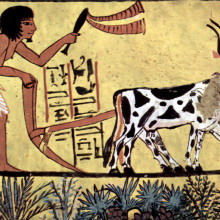
11:31 - Farming moved with ancient migrants
Farming moved with ancient migrants
One of the great questions in archaeology, "did farming move across Europe through the spread of knowledge or people?" now looks somewhat closer to being answered.
Researchers at The University of Uppsala in Sweden have this week published a report that indicates it was the migration of people that brought farming to the continent.
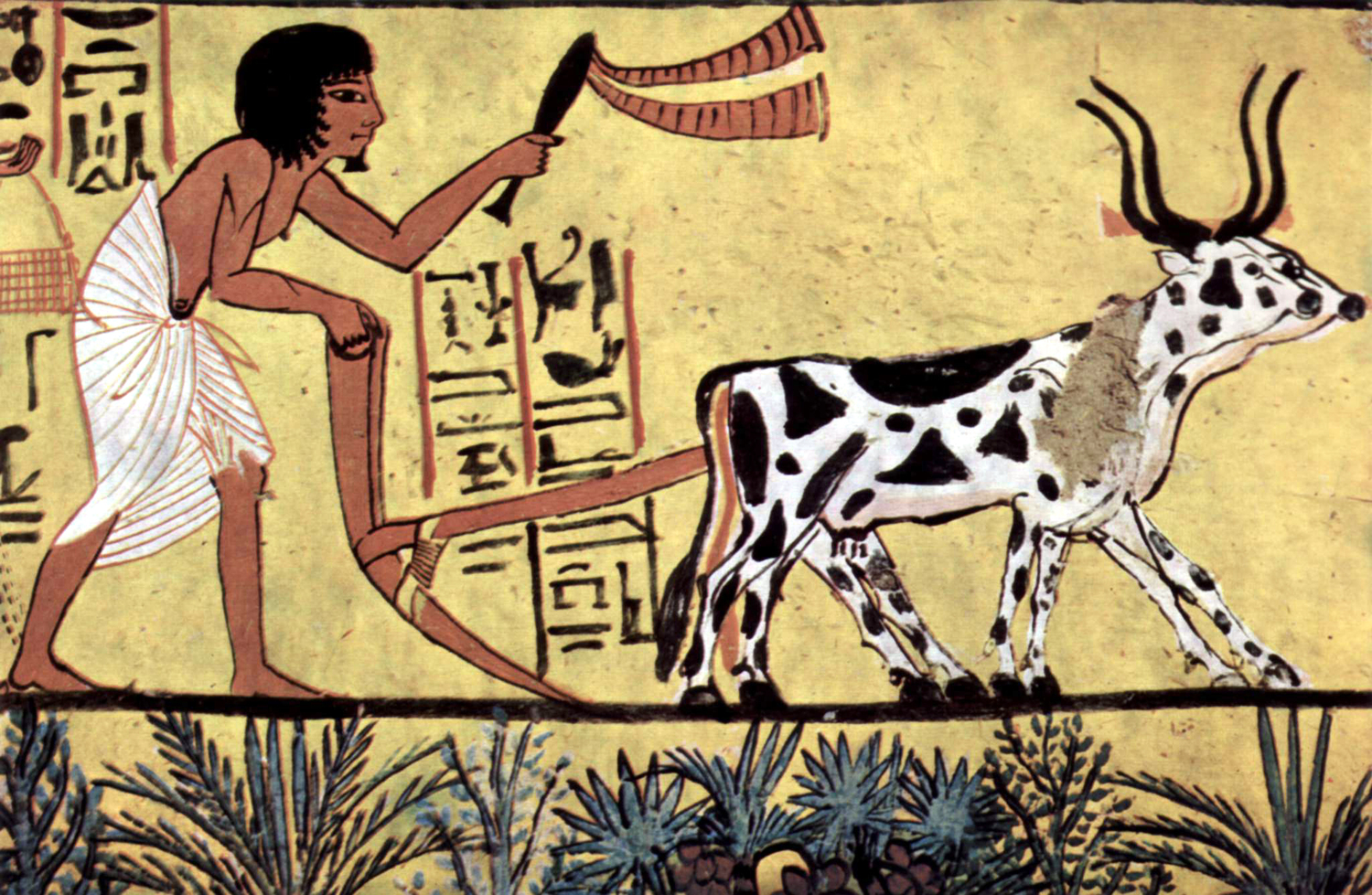 The adoption of farming is seen as one of the great stepping stones in human development. It allows more people to live off smaller areas of land, supporting a population with time to do other things like build impressive monuments and develop new technologies. Across the world there are several areas where agriculture has its origins, and the closest one to Europe is in the Near East, where it's thought farming started around 11,000 years ago.
The adoption of farming is seen as one of the great stepping stones in human development. It allows more people to live off smaller areas of land, supporting a population with time to do other things like build impressive monuments and develop new technologies. Across the world there are several areas where agriculture has its origins, and the closest one to Europe is in the Near East, where it's thought farming started around 11,000 years ago.
Farming took around 6,000 years to move across Europe, but in order to work out how that spread occurred, archaeologists have several clues to work on. The usual lines of evidence are ceramics, technology and language. But the Swedish team, led by Pontus Skogland, looked at the problem using the DNA of four 5,000-year-old individuals. One of these was a farmer, buried on the Swedish mainland, while the other three were hunter gatherers that were excavated on the island of Gotland, 250 miles away.
What they found was that the two groups of people had quite different markers for their origins. The hunter-gatherers shared much of their genetics with modern Finnish populations, and the farmer shared a greater proportion of his DNA with Mediterranean populations of today. This implies that the farmer was a migrant, or at least a descendant of migrants, and that European hunter-gatherer populations were replaced, to some degree (there was probably some admixture).
It looks like farming was indeed spread along by a movement of people rather than a simple transmission of culture and knowledge, and that this has affected the genetic diversity present in Europe today. You can find out more about that story in the journal, Science.
Why do salts dissolve better in warm water, but not gases?
Chris - It does sound a bit counterintuitive doesn't it? The simple reason, chemically, is if you were trying to dissolve some salts, let's take table salt - sodium chloride - as an example. Sodium chloride consists of sodium ions Na+ and chloride ions Cl- and they're in an ionic lattice where the sodium has given an electron to the chlorine so you've got the sodium plus and the chloride minus.
Water has a dipole. What that means is that water molecules, H2O, have an oxygen in the centre which loves electrons and it's a bit minus, and the hydrogen which holds on to its electron slightly less well ends up being a little bit plus.
This means that when salt mixes with water, the hydrogen ions can grab hold of the chloride because they're minus and the hydrogen is a bit plus. The oxygen can grab onto the sodium and form an interaction and as a result, the ions want to move in to contact with the water molecules.
If you warm the solution up, the water molecules have more kinetic energy because the temperature is higher, therefore they will interact with more energy with the salt and therefore, they'll find it easier to bring those ions into a solution and hang onto them.
On the other hand with gas, it's slightly different and the best explanation I came across to explain this was in terms of what we call partial pressure. In other words, the relative proportion of a mixture that a gas makes up. If you increase the temperature of a gas, it wants to expand so it takes up more space effectively, the pressure is higher. So if the pressure is higher, the gas wants to take up more room or push harder on other things around it, electrically speaking, and as a result it's going to find it harder to sit in a solution of water molecules which were all trying to interact with each other. So therefore, when the temperature is higher, gases find it harder to dissolve but when the temperature is lower, gases dissolve much better. And that's why you find there's actually much more oxygen in the water around the Antarctic, so you get creatures that are very, very big there compared with warmer water which can sustain less oxygen tension and also, if you want to keep your fizzy drinks fizzier, putting them in the fridge works exactly the same way; the CO2 will dissolve better when they're actually cold in the fridge.
Dave - Another way to think about it is that for salt to dissolve, you've got to break bonds and that takes energy. So the hotter it is, the more energy there is about, so the easier it is to break those bonds. So the hotter it is, the more likely the salt is to be dissolved. But similarly, for the gas to escape from the water, it's going to take energy because there will be some bonds in there, so the hotter it is, the more likely it is to come out as a gas.
When looking at distant objects, are we looking at the past?
Chris - Effectively, yes you are. Light travels at 300,000 kilometres a second - very, very fast. Rather than report distances in terms of miles, kilometres, or metres in space, it's more convenient to say, "how long would light, travelling at the speed of light, take to go from where it started to us here on Earth?" And actually, it conveniently works out as about a billion miles an hour.
So if you sent a radio message, which is a form of light, between the Earth and Pluto, Pluto is about 6 billion kilometres away, so it would take about 6 hours for your message on your mobile phone or your signal to go from here to Pluto. If someone then sent a message back from Pluto, it would again take about 6 hours for that message to come back. So it'd be a pretty slow conversation.
So in other words, yes, there's been a very big delay in time between the time that your message was sent from one place to the other place and that means a time lapse must have happened because light has a finite speed at which it can travel.

18:46 - Diversity of life down to distant supernovae
Diversity of life down to distant supernovae
The timings of supernova explosions close to Earth marry up with epochs in the planet's history when the diversity of life altered dramatically, suggesting they may  have played a role in driving evolution.
have played a role in driving evolution.
Species diversity on Earth has varied significantly over the last 4 to 500 million years; and although it is hard to measure this in larger animals, looking at the number of genera of well-preserved marine organisms within the fossil record, it rises rapidly to about 250 million years ago, then drops rapidly by about 200 million years ago and then increases again over the last 100 million years or so.
Geologists have used plate tectonics to account for these trends, arguing that this alters sea-level and atmospheric chemistry and in turn the temperature. The overall effect, they argue, is more shallow seas, giving rise to more complex coastlines and a more varied marine environment. So you would expect more diversity of species.
But this may not be the whole story. Henrik Svensmark has been looking at a different source to explain the changes: supernovae, the explosions that punctuate the end of a star's life, producing in their wake powerful surges of cosmic particles and radiation. For now, he's confined his analysis to events that have occurred within about 5000 light years of Earth.
To spot where and when they may have happened, he looked for stellar congregations called "open star clusters", where star-forming events have occurred in the recent past. He reasoned that, if stars were forming in these places, some of them will have been the short-lived massive stars that form supernovae.
Comparing these predictions with records of cosmic rays preserved in meteorites produced a strong agreement. He then compared the cosmic ray records from the last five hundred years with the numbers of marine species. The match is striking. There are peaks 250 million years ago, and again now.
Svensmark speculates that high energy particles issusing from the supernovae could have entered Earth's atmosphere where they produced trails of ions that seeded clouds, cooling the planet and boosting species diversity. Consistent with this theory, when he looked at previously-unexplained rapid cooling events that have hit the planet in the past, there was again a strong correlation with the supernova data.
So, surprising as it sounds, life on Earth may owe its origins not just to our nearest star, the Sun, but also to the deaths of other stars thousands of light years distant...
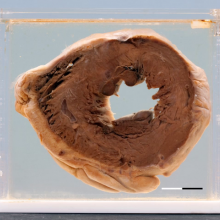
21:32 - Rogue DNA at the heart of cardiac failure
Rogue DNA at the heart of cardiac failure
DNA released by damaged heart cells triggers inflammation and cardiac failure, new reseach has shown.
Writing in Nature this week, Kings College London researcher 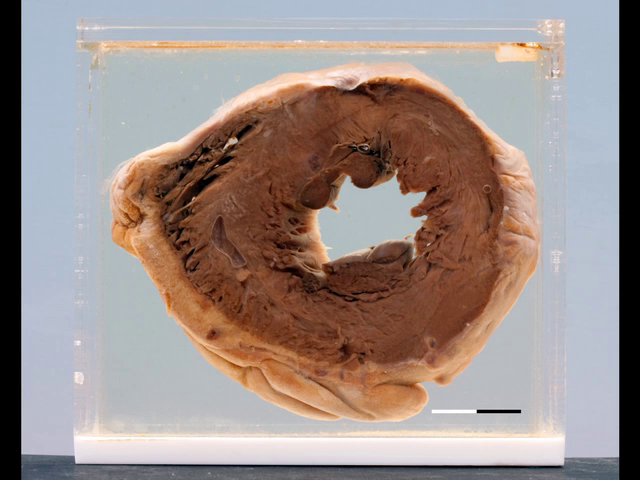 Kinya Otsu and his colleagues first demonstrated, using animals with heart failure, that DNA accumulates in the affected cardiac tissue.
Kinya Otsu and his colleagues first demonstrated, using animals with heart failure, that DNA accumulates in the affected cardiac tissue.
Knocking out the enzyme Dnase2a, which breaks down redundant DNA in cells, also produced mice prone to fatal heart failure. Studies on the animals' failed hearts also showed a dense infiltration of the tissue with immune cells, and the accumulation in the cells of pieces of DNA that appeared to be in the process of being broken down.
But the DNA wasn't from the nucleus, the team found. Instead it was from the mitochondria, the structures inside cells that burn fuels to produce energy. Mitochondria are originally descended from primitive bacteria, which teamed up symbiotically with cells over a billion years ago, providing energy in return for shelter and protection.
The evidence for this relationship is that mitochondria still contain their own DNA sequences, and like the bacteria from which they are descended this DNA is circular. And because it resembles bacterial DNA, this mitochondrial DNA can also triggers an immune response by binding to anti-bacterial detectors called Toll-like receptor 9 (TLR-9) receptors on immune cells.
The stress of heart failure, it seems, causes the cardiac cells to accumulate rather than break down this DNA from their defunct mitochondria. The ensuing inflammation further stresses the tissue, exacerbating the heart failure.
Predictably, knocking out TLR-9, or blocking it with a drug, reduced the severity of the heart failure.
According to Otsu, "When mitochondria are damaged by stress, such as during heart failure, they become a problem because their DNA still retains an ancient bacterial fingerprint that mobilises the body's defences."
Blocking this effect in humans, the scientists speculate, could hold the key to future treatments for a condition affecting three quarters of a million people in the UK alone.

25:42 - Magnetic Fields on the Brain
Magnetic Fields on the Brain
with David Dickman, Baylor School of Medicine in Texas
Chris - Also this week, scientists homed in on the parts of a pigeon's brain that enable it to use the Earth's magnetic field to navigate and Louise Anthony has been finding out a bit more...
Louise - Pigeons, as well as a host of other species including bats and fish, are known to be sensitive to magnetic fields and they appear to be able to use them to find their way around. But exactly how these animals detect and then process this information neurologically has always remained a grey area. Now, working with homing pigeons, David Dickman from the Baylor School of Medicine in Texas, together with his colleague Le-Qing Wu, has identified the parts of the brain that give these animals their mental compasses. Dickman and Wu reasoned that nerve cells involved in decoding magnetic signals should be activated by changes in the surrounding magnetic field. So to track down these cells, as David Dickman explains, they began by exposing a group of birds to a changing artificial magnetic field and then looked in the animals' brains for nerve cells that had switched on a gene called c-Fos, which is an indicator of nerve cell activity.
David - We put birds inside a magnetic field, rotated the magnetic field around their heads, then reacted the brain tissue for the c-Fos antibody and we found four major locations that were strongly activated by magnetic stimulation. One of them turned out to be in the vestibular nuclei, another in the anterior thalamus, an area that processes spatial information and the third was the hippocampus which is well-known to be a spatial memory centre. The fourth was an area of association, visual cortex.
Louise - These are all regions that are known to be involved in navigation functions and spacial orientation. In other words, knowing where you are, what position you're in, and in which direction you're pointing. Next, to find out how these nerve cells might be processing magnetic information, Dickman and Wu placed 7 pigeons in changing magnetic fields of a similar strength to the Earth's own magnetic field, and then used electrodes to record the nerve activity in one of the brain regions they'd already identified - the vestibular nuclei - which also helped to control balance.
David - We placed birds in the dark because there's a competing idea that the retina has a photo pigment contained inside the retina itself which could be reactive under certain wavelengths of light to a magnetic field. We didn't want to activate those receptors if they exist, so we put the birds in total darkness and they were motionless because we didn't want to activate the vestibular system since we're recording from vestibular cells. So while they sat there quiet, we rotated this magnetic field around them in different planes and we found that the neurons are all tuned to a specific direction in space and the tuning is really interesting because the neurons respond when the magnetic field is pointed basically in all directions except one plane where they're silent, and they build up the response so that when the magnetic field is pointing in one direction, the cell likes it the most and when it's pointing opposite that, the cell likes it the least.
Louise - And the responses of those cells effectively signal the strength, direction and the polarity of the magnetic field; In other words, whether the bird is pointing north to south or south to north, and this means that the birds can most likely use this information to work out where they are.
David - If you look at the Earth's magnetic field, what you see is that field lines come out of the south magnetic pole, they circle the Earth and they go back in, in the north magnetic pole. And they come out of the Earth at different angles, depending upon whether it's the south, north or the equator. It's 90 degrees at the poles and it's zero at the equator and then it varies systematically between the equator and the poles. That's called the inclination angle. These neurons theoretically could use that inclination angle to tell you your latitude.
Louise - But what they still don't know is how the birds are actually detecting the magnetic field in the first place. So whether it's a magnetically sensitive chemical in the eye or deposits of an ion containing mineral like magnetite - that's still a mystery, but there are several possibilities.
David - There are three candidates out there - the retina, using these photo pigments. We've never looked at retinal cells before. There's also the inner ear, where there are these iron particles that were found by another group; and then the beak, although the beak looks like the magnetite is macrophages, it could be that there is still a mechanism there but is yet to be discovered. There are behavioural studies that suggest that the beak is involved, so we really don't know. We'll probably go after the receptor in the inner ear first because we're familiar with that territory and we've done some preliminary experiments about that already.
Louise - So, for the moment at least, the jury is still out, but in the meantime, there are some very real potential spinoffs from this work that could benefit us too.
David - Humans often have disruptions in their spatial orientation ability, particularly people with dementia or people that have inner ear disease such as Meniere's disease. They find it very difficult to sometimes even find their way in the kitchen if the lights are turned off and they lose their way when they're driving from home to the grocery store. So, we have an idea now about how the brain is taking some signals and feeding in to this, what we call the navigation network. So we're hoping that will lend us some clues that we might be able to use in the future to help people with spatial orientation in spatial memory loss.
Chris - David Dickman speaking with Louise Anthony and that work was published this week in the journal Science.
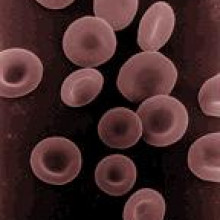
How quickly does a blood cell circulate?
Diana - I think the answer is going to be about a minute for most people. You have about 5 litres of blood in your body (at least most people do) and the average heart pumps about 70 ml of blood out with each beat. The next bit is going to depend on your resting heart rate. I think most people have an average resting heart rate of about 70 beats a minute (somewhere around there). So, if you multiply the amount of blood that the heart can pump by the number of beats in a minute, you actually get about 4.9 litres of blood, which is almost your whole body's worth of blood. So, in a minute, you will pump the entire blood volume around your body.

32:31 - Does exercise lead to a bigger heart?
Does exercise lead to a bigger heart?
Chris - Well actually, it does cause a bigger heart and it can happen for both good reasons and bad reasons. If you have a very high workload on your heart because you, for instance, have high blood pressure all the time, then you can develop cardiac hypertrophy and this is where the muscle of the heart becomes thickened, bigger, and beefier in order to do more work and overcome the extra load applied to the heart by the high blood pressure. Now, that's a bad thing, obviously; sometimes the muscle can become so big that, in fact, it has an oxygen demand which is bigger than the coronary arteries are capable of delivering via the blood. So, people can get angina - pain in their chest - caused by the heart not getting enough oxygen - because the heart has become pathologically large.
More normally though, people who do a lot of exercise along the lines of what you've been describing, Olympic athletes for example, footballers for example, you'll often hear them say that their resting pulse rate is really low. They might say, for example, that, compared with a normal person who has a resting pulse rate of say, 70 beats per minute, their heart beats only 40 or maybe in some cases, 30 times per minute. Now the reason that can get away with beating more slowly is because their heart has become larger in response to their regular training and the demands they place upon it. And that means that, because it's bigger, it's working more efficiently. With every beat of the heart, it actually pumps out more blood than a smaller heart in an untrained person. So, as a result, they don't have to make their heart beat as often because every time it does beat, it pumps out two beats worth of blood, so their pulse rate can come down. And, if you measure the maximum output from their heart, you'll find that their maximum output can be say, 30 litres in a minute when they're working really hard, compared with say, 25 litres in someone who's unfit and untrained. However, the maximum number of beats their heart can make in a minute will be lower than an unfit person because a bigger heart takes longer to fill up with blood, so they have to slow down their pulse rate and they just make their heart eject more. This form of cardiac enlargement is not thought to be bad for you. It's a physiological response to increased workload and, in the short term at least, we think that it isn't harmful.
Why would raspberries spark in a microwave?
Dave - I imagine it's related to microwaving grapes. If you get a grape, cut it almost in half, so it's got a little bit of skin holding the two halves together and then open it up, and put it in the centre of the microwave where there's lots and lots of power. a microwave oven cook things by forcing electric currents to flow backwards and forwards in them, and you end up with a lot of current flowing through this little bit of skin that then dries out. Then you get the current wanting to flow across the gap and it actually jumps as a spark. So my guess, what is happening with your raspberries is you're getting raspberries very close together or just touching - that gap then dries out and it sparks across the gap.
Chris - Also, raspberries are lots of little mini segments aren't they and I wonder if maybe each of the mini segments are behaving a bit like a half of a grape with the segment next door, do you think?
Dave - It's possible although I would've thought that the contact between them was fairly good especially as it's heating up and getting mushy.
Why do doors creak?
Dave - If you have a door which is getting a bit old, getting a bit rusty and you haven't oiled it properly, you get a very similar thing to brakes squealing or in fact, dragging finger nails down a blackboard. It's to do with stick and slip. What happens is that you get quite a lot of friction and there's a lot more friction when two things are stationary than when they're moving. So, essentially the two bits of the hinge lock together, then the hinge bends a bit, and then the force gets enough for it to break, and it jumps forward a bit and then it stops, and then it bends a bit, and it jumps forward.
This jumping can happen at a range of pitches, including the horrible 50-100 Hertz range. As you're getting jump, jump, jump, jump, what you hear is this horrible creak noise.
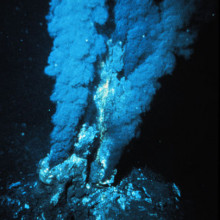
37:38 - Exploring Life at Hydrothermal Vents - Planet Earth Online
Exploring Life at Hydrothermal Vents - Planet Earth Online
with Clare Woulds, University of Leeds
Hydrothermal vents were only discovered in the 1970s but have turned out to be some of the most fascinating ecosystems on Earth. These deep sea geezers are teaming with unusual life from a species of weird pale octopus to the recently identified 'hoff' or yeti crab as described on our podcast earlier this year. But there are some fundamental questions scientists studying hydrothermal vents don't yet know the answers to.
Clare Woulds at the University of Leeds, for instance, is investigating food webs, what does everything living in the sediments around hydrothermal vents eat. Richard Hollingham went to visit her lab in Leeds where she showed him the samples that she works on...
Clare - I have to ask you not to touch bits of this freezer, because I've got nice big blue insulated gloves on but if you touch it you will get stuck to it and then we have serious problems.
Richard - Phwoar! You can feel the cold, it's like a slice of Antarctica just there - I'm not touching it.
Clare - Ok, I'm going to open this bottom drawer here - so this is the one that my samples are kept in - and these bags of mud are mine, you can hear the crackle, that's just a plastic bag but because it's so cold it sounds really brittle. We'll take these out and put them on the bench and have a quick look.
Richard - So, we've got frozen sediment samples from where?
Clare - This site is called Hook Ridge, and it's what we call a defuse hydrothermal venting site. Instead of this rocky bottom with chimneys there is actually a cover of soft sediment or mud over that, so the hydrothermal fluids are coming bubbling out through the mud. That's the type of site that these come from.
Richard - I have to say if we can look through the bag - again, I'm not going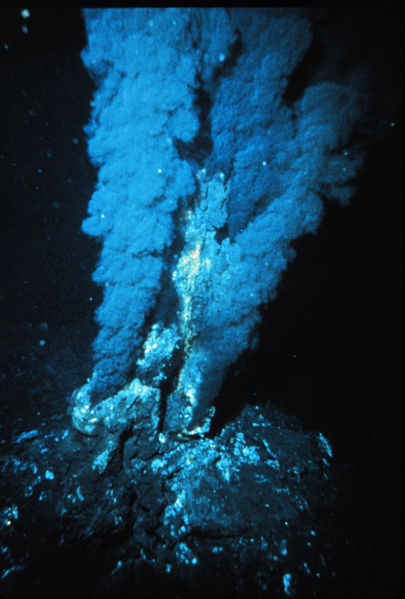 to touch that - it just looks like crisp sized bags of frozen mud.
to touch that - it just looks like crisp sized bags of frozen mud.
Clare - That is actually what it is, but they're very carefully labelled bag of frozen mud.
---
Richard - And appearances can be deceptive because the sediment is full of life...
---
Richard - So, we've come into the microscopy lab and appropriately enough, there is a microscope and under there you've got a sizable petri dish.
Clare - This is a sample that was preserved slightly differently. It was pickled, if you like, in formalin and what I've done this morning is I've taken the whole sediment sample and I've sieved it. And what we're looking at is the coarse fraction greater than 250 microns in size, that's a quarter of a millimetre, so still quite small, and we're going to have a look at it under the microscope to see what animals are living in the sediment that we can pick out for analysis.
Richard - Let's have a look... What are you trying to find out?
Clare - I'm interested in carbon cycling. That really means where is the food coming from for this ecosystem and how does that food travel through the ecosystem. So who is eating what and who is eating who else.
Richard - And how are you doing that?
Clare - At a hydrothermal vent system we have a really interesting phenomenon in that the biological community there has two different sources of food. Mostly in the deep sea there's only one source of food and that's food that falls down from the surface ocean from plant production in the surface ocean. At hydrothermal vents there are really interesting microbial communities that can also make food just like plants do at the surface, but instead of using sunlight, because there's no sunlight at 1500 metres in the ocean, they use the chemical energy from all of these strange volcanic fluids seeping out of the sea floor. So this biological community has a choice of two different food types. It can eat algae sinking from the surface of the ocean or it can eat bacteria that are producing food in situ on the seafloor. The thing we don't know is to what extent is this community reliant on those two different types of food, so where is the carbon coming from and how is it being cycled?
Richard - And how are you trying to look at that and investigate that?
Clare - I did some experiments where I collected sediment cores, I collected tubes full of sediment, that had all of their natural structure and their natural biology intact. I then added chemical labels to those cores. Some of that was chemically labelled algae and in different cores I added a chemical label that the in situ bacteria would take up. I'm then going to pick out the animals from these sediment samples and see which animals eat which different type of food.
Richard - And is it quite exciting to be working on something that really we've only started exploring in the last ten to twenty years?
Clare - Yes, that's fantastically exciting. I feel very privileged to be in this position of doing something for the first time. It's really exploratory and that's fantastically exciting.
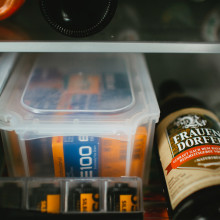
Should I completely fill my freezer?
Physicist Dave Ansell answered this question...
Dave - Yeah, there's a couple of things which might affect the efficiency of your freezer, depending on how much it's got in there. I guess, first, if you put something warm in there, then you're going to take a load of energy to pump the heat out of it. But assuming you've already got the stuff cold, which is best, if you have an upright freezer, when you open the door, all the cold air is denser than the warm air, so all the cold air falls out. You're essentially putting in heat by all the warm air which is taking its place, and you shut the door and it's got to re-pump that heat out again.
Chris - So the more stuff that's in there, the less room there is for warm air to go in and push cold air out, so the better then?
Dave - That is correct, up to a point. If you jam every corner absolutely full of stuff, you can then get other problems because the way the freezer knows how warm it is is you've got a thermostat in there and if the cold air can't get from the cooling elements to the thermostat then it's going to keep making them colder and colder. The bigger the temperature difference, the more the freezer's got to work from between the room and the temperature inside the freezer, the harder work it is and so the more energy it uses. So, if the cooling elements are actually at -30°C rather than -20°C, that's going to be costing your electricity. So fairly full, but not so full that air can't circulate at all!
Diana - So I guess it is a good idea to defrost your freezer occasionally so you don't get that build up of huge chunks of ice if you haven't got a frost-free freezer?
Dave - Yeah, especially as that is even worse than filling your freezer right up because it insulates the cooling parts of your freezer, so the cooling parts could get even colder which then causes even more ice. It is a horrible vicious circle and you end up running your freezer continuously and not actually ending up with a very cold freezer.
Is there such a thing as a "girl's throw"?
Diana - I had a little think about this and first of all, we probably need to define what a girl's throw is. I think it's probably when you try and throw something overarm and you just use perhaps the lower portion of your arm; So, the upper portion where your humerus and bicep and all that is, doesn't really move and it's just your forearm that's doing the throwing, and your hand of course. So, the question is, why would only a girl be throwing in this manner and I think it's actually probably something that's a bit more cultural than necessarily anatomical because...
Chris - Learned helplessness. Is that what you're saying?
Diana - Yeah, learned helplessness(!) But I think a few decades ago, perhaps not so much now, the practice was to take your daughter and give her dolls and make her do girly exercises, and then with your boys, you take them outside and play football with them or play catch and throw, and that kind of thing. So, I think for a lot of girls, they probably just didn't learn the techniques of throwing properly and so, the sort of automatic response to throwing something is to kind of do it in this funny over arm way and perhaps not underarm or using the proper sort of baseball throw.
Dave - I was not a very outdoors boy and it took me until I was about 11 or 12 to learn how to do that throw which seems to involve throwing your elbow forward, storing energy in your elbow, and then flicking your hand over...
Chris - You do a physicist's throw. So do you analyse this in a sort of physics way and go, "How can I impart the maximum kinetic energy to the ball by adopting the following anatomical posture?"
Dave - It was more that I noticed that when I did this anatomical thing that it seemed to be working rather well both kind of sideways and upright.
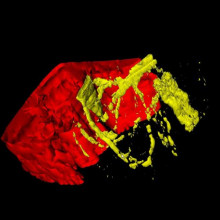
46:36 - 3D Tissue Imaging and Subordinate Meerkats
3D Tissue Imaging and Subordinate Meerkats
with Derek Magee, University of Leeds; Jacqueline Crawley, National Institue of Mental Health; Sobnath Baidya Roy, University of Illinois;
3D Imaging of Human Tissue
High resolution
3d images of human tissues can now be created using a technique developed by scientists at the University of Leeds.
By scanning hundreds of slides of sliced tissues segments at once and converting them into high resolution digital images, the software, developed by Derek Magee, then aligns these to produce detailed, multi-coloured images in 3 dimensions, with over 400 created to date.
The technique can be used on numerous tissue types including tumours and samples of liver disease, and enables samples to be rotated on a computer screen and monitored from any angle.
Derek - Within a human body, some things are inherently 3D structures and looking in the 2D does not give you the same information. So take as an example blood vessels, blood vessels are a branching structure of tubes. If we cut a tube as a 2D section, all you see is an ellipse. So if you look at a blood vessel in 3D, you can actually see this branching structure and you can relate it to the structures around it. For example, a tumour, if that's very close by you can see, well, has that tumour got its own blood supply or is it a very early stage tumour that is yet to develop its own blood supply?
---
New compound to treat Autism
A drug to treat the symptoms of autism has been identified by scientists at the National Institutes of Mental Health in the US.
Working with inbred mice displaying signs of autism such as unusual social interactions, excessive jumping and repetitive self-grooming, Jacqueline Crawley and colleagues found that when the mice were injected with the
compound GRN-529 - which regulates glutamate release in the brain - these behaviours were significantly reduced.
Jacqueline - Treatment with this compound that reduces excitatory glutamate neurotransmission in the brain reduces repetitive behaviours, reduces stereotype jumping, and improves some of the social deficits that are seen in these mice. We may be able to develop pharmacological treatments that might be beneficial to children and adults who have autism. The challenge of course is to find compounds that will be effective in people, but it's one of the most promising leads that we've seen for quite a long time.
---
Climate warming by wind turbines
Large wind farms may be affecting local weather and climate in the US.
With the US wind industry growing rapidly in recent years, scientists at the University of Illinois analysed satellite data for the land surface temperatures of four of the World's largest wind farms in Texas, to see their effect on local land surface temperatures from 2003 to 2011.
The team found a warming effect of up to 0.72 °C per decade when compared to nearby regions lacking these farms.
Somnath Baidya Roy co-authored the study.
Somnath - Turbulence generated by the spinning of the wind turbine rotors mixes air up and down, and the key impact of this is a warming effect near the surface and on the land surface at night. Now, wind power does not generate almost any carbon dioxide emissions and hence, wind power is going to be a part of the solution to the climate change problem. Understanding the impacts of wind farms will help us develop efficient adaptation and management strategies and thereby contribute to a long term sustainability of wind power.
---
Subordinate Meerkats are the best problem solvers
And finally, subordinate members of a meerkat social group are the best at solving problems.
Alex Thornton from the University of Cambridge set tasks for 7 groups of wild meerkats where the animals were required to open or break into transparent containers to reach the scorpion supper located inside.
The team found that lower ranking members of the group, and particularly males at this rank, were the most successful at solving the task.
Alex - The reason for this is probably that these individuals are unable to outcompete others. So unlike their dominants, they can't bully their way to get food rewards. So, there are advantages for them to try and find out new ways of solving problems. For the males, this is particularly advantageous because they're the sex that disperses, that goes out to seek mating opportunities, so they're going to be encountering new difficulties in the world and so it will make sense for them to try and find out ways of solving new problems.
And that work was published in the journal Animal Behaviour.
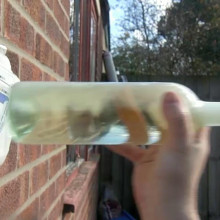
Opening a bottle of wine without a corkscrew

55:34 - Why don't women have beards?
Why don't women have beards?
With the answer is evolutionary expert Professor Robert Foley from Cambridge University....
Robert - Really, the question is why have women lost more hair in the course of our evolution than men have? If we go back to our evolutionary origins and think of the fact that we share ancestry with apes and monkeys, what is unique about humans is that we have generally lost hair. Hence, some of us hear the expression 'the naked ape'.
It's actually not quite true to say we are hairless or the naked apes because we've kept hair in many parts of our body and partly because we haven't actually lost the hair. It's just become highly miniaturised, almost certainly because it gave an adaptive advantage in particular, helps keep cool, possibly related to having more upright posture, possibly relating to being much more active and running.
Now the question being asked is why aren't we all equally hairless? Well to some extent, of course, people across the world vary enormously and then of course there's a big difference between men and women, and the answer most likely is to do with sex or selection. This is the second of Darwin's great mechanisms, that selection doesn't just work to fit people in the natural environment.
It also comes about because individuals select the traits of the people they want to reproduce with, and probably, it's the case that loss of hair, a key human characteristic, becomes more important in selecting for women because it makes them more attractive. So while all humans have been selected to lose hair, the process of how you choose a mate has extended much more in women than in men.
So the real question perhaps is, why should that be attractive and I'm afraid that's probably something of a mystery.
Hannah - And Clifford K. on the forum suggests that society has adapted to preference of youthful looking women for longer healthy child-bearing years and having a hairless chin may make females look younger, providing the possible reason for the sexual selection.









Comments
Add a comment